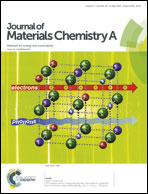Combination of a SnO2–C hybrid anode and a tubular mesoporous carbon cathode in a high energy density non-aqueous lithium ion capacitor: preparation and characterisation†
Abstract
Lithium ion capacitors (LICs), bridging supercapacitors and lithium ion batteries (LIBs), have recently drawn considerable attention. In this report, a non-aqueous LIC was fabricated using tubular mesoporous carbon as a cathode and a SnO2–C hybrid (ultrafine SnO2 encapsulated in the tubular mesoporous carbon) as an anode. Such a LIC can achieve a maximum energy density of 110 W h kg−1 and a maximum power density of 2960 W kg−1. The capacitance retention is fairly stable and retains 80% of its initial value after 2000 cycles. This unique performance arises because of the highly conductive tubular mesoporous carbon matrix and fast charge/ion diffusion in the SnO2–C hybrid anode. It is shown that the SnO2 loading in the anode has a great influence on the stability of the SnO2 nano-structure and the kinetics of lithium ion transfer. Electrochemical impedance spectroscopy (EIS) was used to evaluate the charge transfer resistance and the ionic diffusion resistance before and after long-term cycling. The diffusion coefficient was also calculated to verify the good rate and cycling capability.


 Please wait while we load your content...
Please wait while we load your content...